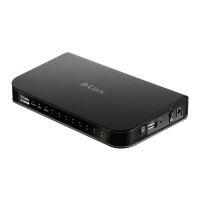D-Link DSR-Series User Manual 152
Section 7 - VPN
GRE
VPN > VPN Settings > GRE
GRE tunnels allow for broadcast trac on the LAN of the router to be passed over the internet and received by
remote LAN hosts. This is primarily useful in the D-Link Discovery Protocol (DDP) application where broadcast
trac from one LAN host is to be received by all LAN hosts in the local subnets of the GRE endpoints.
Note the following limits for the number of supported GRE tunnels per product:
• DSR-150/150N: 5
• DSR-250/250N: 10
• DSR-500/500AC: 15
• DSR-1000/1000AC: 25
There are two simple steps involved in establishing a GRE tunnel on the router:
1. Create a GRE tunnel from the GUI
2. Setup a static route for the remote local networks using the GRE tunnel
When creating the GRE tunnel, the IP Address should be a unique address that identies that GRE tunnel endpoint.
It will be referenced in the other router’s static route as the Gateway IP address. The Remote End Address in the
GRE tunnel conguration page is the WAN IP address of the other endpoint router.
Once the tunnel is established, a static route on the router can be made using the interface set to the congured
GRE tunnel name. The destination IP address of the static route is the remote LAN subnet, and the route’s gateway
IP address will be the GRE tunnel IP of the terminating router (the same router that manages the remote LAN
subnet). Once these two steps are completed, all DDP broadcast trac can ow between remote LAN subnets
via the GRE Tunnel.
To create a GRE tunnel:
1. Click VPN > GRE > GRE Tunnels.
2. Click Add New GRE Tunnel.

